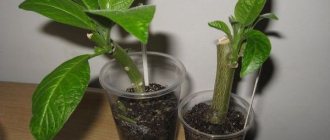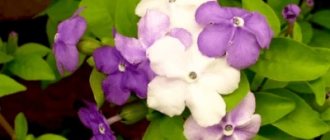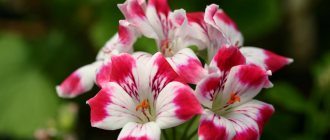The fashion for exotic plants, with non-standard shapes and lines, affects not only landscape design, but also the world of indoor plants. Today on store shelves you can find a huge number of modern ones, with daring lines and unusual “prickly” inflorescences of crops. One of these is exotic turmeric. In a plant with luxurious inflorescences formed by pink, white or purple apical leaves, everything seems original. And at first glance it’s hard to believe that this is the same plant from which the famous bright yellow spice is extracted. Indoor turmeric is a capricious crop that requires digging up for the winter. But it can become the real pride of the collection and a unique interior decoration.
Flowers of Turmeric altisfolia. © Pretty Kate Machine
Potted turmeric is more than just exotic
Turmeric in indoor cultivation is a relative of the plants from which the legendary saffron substitute is obtained in India. This is an exotic plant in every sense that can compete in showiness and style even with the recognized favorites of greenhouse floriculture. The Siamese Tulip is impressive, with amazing symmetrical lines, as if it embodies all the beauty of Indian flora.
The secret to the success of turmeric in indoor culture is the perfection of shapes and lines, bright individuality and non-standard flowering. But turmeric does not retain its beauty all year round: the above-ground parts of this plant completely die off during the winter and it must be stored outside the soil. In this, all types of indoor turmeric are very similar to corms and bulbous ones.
Among the numerous types of turmeric in indoor culture, the two most common are turmeric altisfolia and cedoaria .
Exotic turmeric cedoaria , also known among amateur flower growers as citvar root, is an exotic and very impressive plant. It evokes universal admiration during the flowering period. But in fact, it is not the flowers of the plant that are beautiful, but the apical leaves on the shoots. They form a false inflorescence, hugging the shoot like petals and creating a funnel-shaped inflorescence at the tops of the shoots, partially reminiscent of lotus flowers. The bracts are arranged in a spiral, which only adds to the charm of turmeric.
Up to 7 inflorescences bloom on one plant. The shape of the apical leaves is modified, they are beautifully pointed and petal-shaped, and the color is luminous, often almost porcelain and very bright.
Flowers of Turmeric cedoaria. © ogrodkroton
Traditionally, turmeric cedoaria is colored acrylic pink, but on sale you can also find various colors of the white-pink-violet spectrum. The only thing that remains constant is the purity of tone. In indoor cultivation, this turmeric will reach a height of 20-50 cm. Its leaves are lanceolate, spear-shaped, long, grow straight, wider than those of other species, and beautifully curved at the ends.
Common turmeric - the tallest of the indoor species is popularly called the Siamese tulip. It develops in the form of a more elegant, slender, unusual bush, whose leaves grow from rhizomes. Straight, lanceolate, they seem quite rigid, painted in a cool dark green color. The height of common turmeric reaches 40-80 cm.
Its flowering pattern repeats the characteristics of Cedoaria: at the top of the straight peduncles, bracts, or apical leaves, are arranged in a regular order, which hide inconspicuous white flowers. These pink, white, fuchsia “petals” are what give turmeric its exotic beauty. The lines and structure of the inflorescences surprisingly elegantly echo the leaves, the whole plant seems modern and non-standard.
In addition to these two types, both domestic turmeric and Sumatran turmeric are also found on sale. All representatives of the genus are similar to each other both in terms of growing conditions and in appearance. The difference is only in the shape of the bushes and leaves, but it is also insignificant.
The flowering period of turmeric traditionally covers summer, lasting from June to the end of September.
The flowers of Turmeric altisfolia are also called Siamese tulip. © On.My.BigfOot
general description
Both in natural conditions and in potted culture, the height of turmeric can reach 1 meter, depending on the species. It has a round, thick brown rhizome, inside painted in a characteristic orange color. Dark green or bluish leaves on long petioles of a broad linear shape with an even, smooth edge.
On tall peduncles there are inconspicuous flowers with very beautiful bracts. They are collected in apical inflorescences reaching 15-25 cm in length. Each adult plant usually contains several peduncles. Flowering usually occurs in July-October, each flower stays on the plant for about 3 months.
Through selection, varieties have been developed with different colors of bracts and a dwarf form not exceeding 25 cm in height.
Turmeric development cycle similar to bulbs
Turmeric develops in cycles. After flowering is completed, the leaves of the plant wither in September-October. And this is the main signal for turmeric to enter a period of rest. At this time, you need to adjust the care, stop feeding and reduce the humidity of the substrate. After the leaves have completely died off, turmeric must be removed and the rhizome must be stored outside the soil during the entire dormant stage. Turmeric will not come out of it on its own and you cannot expect any signs of growth of this plant.
To achieve the beginning of the active phase of the growing season, it is necessary to independently stimulate the development of the buds. To do this, in the third ten days of February or the first ten days of March, the rhizomes need to be planted in a new substrate, transferred to warmth and light, and meager watering should begin. Turmeric wakes up slowly, but then begins to develop very actively. Only then is she transferred to standard care.
Turmeric first develops peduncles and flowers, and then leaves appear. But due to the fact that the inflorescences last for several months, the plant will be attractive until mid-autumn. As a result, throughout the warm season, turmeric serves as a luxurious accent in the interior.
Lighting for turmeric in indoor culture
Turmeric is a plant that is very demanding on lighting. But only according to one parameter - protection from direct sunlight. A direct, sunny location should not be allowed, but any diffuse lighting from light partial shade to a bright location is quite suitable for this exotic beauty. It’s easy to choose lighting: the plant itself signals by the lighter color of the leaves and bracts that it is better to move the pot to a lighter place. If turmeric is attractively bright, it means it is comfortable.
The dug up rhizomes of the plant are stored in complete darkness in winter: access to light to the roots at the stage of complete dormancy can be destructive.
Turmeric zedoaria, Zedoaria root, Zedoaria, Turmeric zedoaria, White turmeric (Curcuma zedoaria). © spaldingbulb
Application
Turmeric is highly decorative, but primarily it is a spice and a medicinal plant.
In cooking
Turmeric longa is used to make herbs and spices. Aromatic turmeric is used in the confectionery industry. Turmeric Cedoaria (Tsitvar root) is suitable for making liqueurs. All three species are known as Indian saffron.
Turmeric longa is known as turmeric outside India and is a cheap substitute for saffron. It can be used to tint curry, mustard, cheese, margarine, and chips.
Turmeric roots and powder
In medicine
Turmeric is a natural antibiotic and has blood thinning and heart pressure lowering properties. It lowers blood sugar levels, strengthens the walls of blood vessels and helps with diseases of the gastrointestinal tract, has antioxidant properties, and is used in the treatment of fungal diseases.
Research is being conducted on the beneficial properties of turmeric. There is evidence that it alleviates the course of Alzheimer's disease and has antitumor properties. Thanks to frequent consumption of turmeric, there is virtually no cholecystitis in India.
If you are taking medications and want to use turmeric for medicinal purposes, first consult your doctor - the root of the plant tends to enhance the effect of certain medications.
In cosmetology
In cosmetology, it is used in the preparation of anti-aging masks, lotions and the treatment of inflammatory skin diseases.
Economic importance
Turmeric Round is a commercial crop and starch is made from it. Turmeric root of all types is a natural food coloring that is stable to light.
Temperature conditions for indoor turmeric
According to its Indian origin, indoor turmeric inherits from the base species a pronounced heat-loving nature. This indoor culture does not like coolness (even short-term). The air temperature in the room where turmeric grows should not fall below 20 degrees. But the plant cannot tolerate too much heat, becoming more demanding of air humidity. Try to keep your turmeric growing in stable temperatures of 20 to 22 degrees Celsius or slightly higher.
During the complete dormant stage, after removing the rhizome from the soil, turmeric should be kept within a temperature range of 15 to 18 degrees. Specify the specific temperatures at which you need to store dug out rhizomes when purchasing: depending on the type, turmeric can be stored both at standard temperatures and in much cooler conditions - from 7 to 9 degrees. Ask what kind of wintering your beauty will need.
In summer, actively growing and flowering turmeric can be exposed to the open air: it will not even be afraid of being taken out into the garden.
Watering turmeric abundantly and being smart about hydration
Maintaining high humidity is critical to success in growing turmeric. The plant needs it only at the stage of active development, while both humidifiers and regular spraying can be used to maintain high performance. The bracts and flowers of turmeric are not afraid of getting wet, so even at the flowering stage it will not refuse water treatments. The more often you can spray the plant, the better.
Watering for turmeric is also specific. She is afraid of waterlogging and acidification of the soil. But at the same time, this Indian culture needs stable, fairly high substrate humidity. Between procedures, only the top centimeters of the soil should dry out completely, but it is better to maintain uniform, constant moisture. From the moment turmeric is planted in the substrate and before preparations for digging begin, the soil should not be allowed to dry out completely: even a short drought will be disastrous for turmeric.
Transitions to complete rest and return to the active development phase should be smooth. Watering is reduced and resumed gradually. The longer you extend the reduction in watering, the better the turmeric will prepare for winter.
Common turmeric (Curcuma alismatifolia). © Ray
Pests and diseases
Caring for turmeric at home is easy. It is quite resistant to diseases and pests, which can only appear if the rules of caring for the plant are violated or through contact with infected specimens.
Among the pests that parasitize turmeric are spider mites, aphids, mealybugs, and scale insects. You can get rid of them using special insecticidal preparations.
Spider mite
Aphid
Mealybug
Shchitovka
With excessive watering, the plant is affected by root rot and leaf spot.
Digging up rhizomes
After the leaves on the plant completely wither and the above-ground parts die off, the turmeric rhizome must be removed from the soil. It is carefully removed from the soil, the substrate is removed manually, trying not to damage even the slightest shoots of the roots. After this, the rhizome is allowed to dry at the usual temperatures for several days and is immediately removed for dark and cool storage until spring. You can store rhizomes in paper bags or wooden boxes, or in dry sand. If you were advised to keep turmeric after digging at a temperature below 10 degrees Celsius, then it is better to immerse the rhizome in sand.
Many gardeners who want to make growing easier do not dig the tubers out of the soil. But since in the spring they will still have to be transferred to a new substrate, and the rhizomes in a dry substrate in a pot will still need to be placed in a cool place, it is better to dig up the tubers right away.
Tubers of Turmeric tsedoaria, or tsitvarna, also Zedoaria. © Thamizhparithi Maari
How to care for turmeric in winter: step-by-step instructions
In winter, turmeric needs rest. I advise you to trim the leaves (leave no more than 10 cm in height) as soon as the plant stops flowering in the fall.
To ensure your flowerpot feels good in winter, follow these simple rules of care:
- After pruning, reduce the amount of moisture - spray the soil once a week.
- Move the pot with the root system to a cool, dark place (temperature 15 degrees) or dig up the rhizomes and place them in a box with sand.
- At the beginning of February, you can return the turmeric to its usual place and start watering.
Turmeric is often used in cooking, as are citrus fruits. Read how to grow lemons at home and you will have a beautiful tree on your window that bears fruit.
Planting turmeric in pots
At the end of winter and the very beginning of spring, turmeric needs to be “awakened”. The rhizomes are taken out into the warmth and immediately planted in pots with fresh substrate. Immediately after planting, the first watering is carried out, then the soil moisture is maintained at a minimum, but the plant is still not transferred to abundant moisture. At the first stage after planting, turmeric is transferred to a comfortable warmth and light. Active care is resumed only after the plant begins to actively grow. Frequent watering should be resumed gradually. Fertilizers are introduced a month after planting.
Pots for turmeric are selected according to the size of the rhizome: they should be several centimeters larger than the volume of the rhizome, not too spacious.
Substrate : for turmeric, the main soil parameters are looseness, water permeability, and light texture. This indoor plant prefers soils made from equal parts of humus, leaf, turf and peat soil, with a small admixture of river sand. In terms of acidity, it is better to choose slightly acidic substrates for turmeric. When grown for cutting, turmeric is often planted in a more unusual substrate - a mixture of 1 part coarse sand with 2 parts compost.
What is needed to grow a plant?
The main equipment is a pot or box, soil, drainage, fertilizer and a tray. All this can be easily purchased at your nearest flower shop.
- Dishes for growing . Turmeric reproduces by rhizome. Since it is flat and quite large, pots should be at least 30-45 cm in diameter. It is best if the dishes look like a bowl. Then the root system will have enough space to grow in width. The depth of the pot should also be at least 30 cm.
- Drainage . Expanded clay, small pebbles, polystyrene foam - all this is perfect as a drainage layer. The main thing is that there are holes in the bottom of the pot through which excess water will flow out, and, naturally, a tray for it.
- Soil . The soil should be light, nutritious, permeable to air, slightly acidic. To grow turmeric on a windowsill, you can use citrus soil. Or prepare it yourself by mixing peat and turf soil with humus in equal parts and adding a little river sand.
- Fertilizers . You should not overuse fertilizing with nitrogen, because the rhizome will be used for food, and there is no need for excess nitrates. It is best to use organic fertilizer. Use mineral compounds with caution and little by little.
During the cultivation process, a growth stimulator may be needed. This is a solution saturated with microelements, which give the plant the first impetus to vegetation. Some gardeners pre-soak the turmeric rhizome in it for a day before planting.
Turmeric propagation methods
This plant can only be propagated by dividing the rhizome - turmeric does not bear fruit in indoor cultivation. Dividing can be done on any adult plant before planting in the substrate. The divisions should be large; you should not divide the rhizome into more than 3 parts. In this case, at least 1 bud and 2-3 lateral roots should remain in each division. The separation is carried out with a sharp knife, the sections must be treated with crushed coal.
Turmeric altisfolia, or Siamese tulip
First steps after purchase
It is best to purchase a piece of rhizome in early spring. You need to select a specimen without the slightest sign of rot, with a developed apical bud and at least two lateral shoots.
It is cleaned of the old substrate, planted in fresh soil and placed in a warm, damp place. From the moment the sprouts appear, they begin to water abundantly. If you purchase a ready-made plant in a pot, then it is left in it and kept in a shaded place for several days. It will be possible to replant Turmeric next spring.











